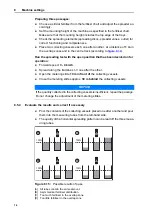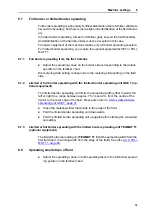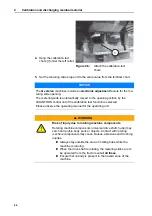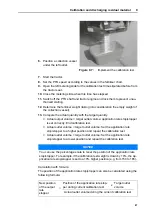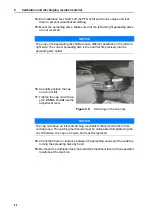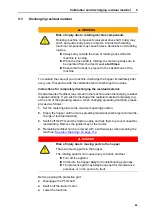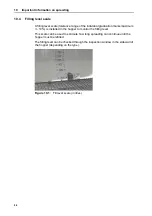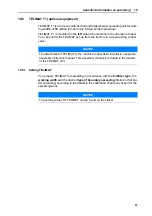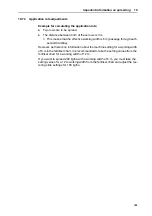
Calibration and discharging residual material
89
9
9.3
Discharging residual material
To maintain the value of your machine, discharge the hopper immediately after
every use. Proceed as with the calibration test to discharge the residue.
Instructions for completely discharging the residual material:
Small amounts of fertiliser may remain in the machine when discharging residual
material normally. If you wish to discharge the residual material completely (e.g.
at the end of the spreading season, when changing spreading material), please
proceed as follows:
1.
Set the metering slide to the maximum opening position.
2.
Empty the hopper until no more spreading material is discharged (normal dis-
charge of residual material).
3.
Switch off the PTO and the tractor engine and lock them to prevent unauthor-
ised starting. Remove the ignition key of the tractor.
4.
Remaining fertiliser can be removed with a soft water jet when cleaning the
machine;
See also “Cleaning“ on page 114
.
Before opening the protective grid:
Disengage the PTO shaft.
Switch off the tractor motor.
Lower the machine.
n
WARNING
Risk of injury due to rotating machine components
Rotating machine components (universal drive shaft, hubs) may
catch and pull-in body parts or objects. Contact with rotating
machine components may cause bruises, abrasions and crushing
injuries.
Always stay outside the area of rotating hubs while the
machine is running.
When the drive shaft is rotating, the metering slides are to
be operated from the tractor seat
at all times
.
Ensure that nobody is present in the hazard zone of the
machine.
n
DANGER
Risk of injury due to moving parts in the hopper
There are moving parts in the hopper.
The rotating agitator can cause injury to hands and feet.
Turn off the agitator.
Climb into the hopper
only
for troubleshooting purposes.
The protective grid may
only
be opened for maintenance
purposes or in the event of a fault.
Summary of Contents for MDS 14.2
Page 8: ...Intended use 1 2...
Page 28: ...Safety 3 22...
Page 38: ...Technical data 4 32...
Page 42: ...Axle load calculation 5 36...
Page 44: ...Transportation without tractor 6 38...
Page 86: ...Machine settings 8 80...
Page 96: ...Calibration and discharging residual material 9 90...
Page 110: ...Important information on spreading 10 104...
Page 114: ...Faults and possible causes 11 108...
Page 146: ......


